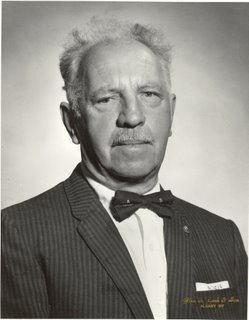Bob Kemp came from an old, illustrious Troy family. An ancestor had founded the Burden Iron Works in the 1800s when Troy was in its industrial heyday. It was the major supplier of horseshoes to the Union Army during the war between the states and a supplier of rails when the west was opened.
Robert’s troubles reportedly started during the early 1930s. Although he was unpopular as an atheist in a very Catholic city, he became hated as an avowed communist, going so far as to publish small books (one of which he showed me) in which he listed himself as “Robert Kemp, Chief Engineer to Josef Stalin, Troy, CCCP.” (Copies are available at the Troy Public Library and the Library of Congress*) He was openly jeered, and his home at 552 Fourth Avenue in the old Lansingburg section of Troy was frequently damaged by young vandals. He was known in Lansingburgh as “Commie Kemp.” He said that sometime after WWII, he became an anti-communist. In a legal pleading, he described himself as “an inventor, scientist, pioneering engineer, venture capitalist, an anti-communistic businessman, an Atheist, and a Heretic.”
At some time before 1963, vandals set fire to his home, causing considerable damage, which he could not repair. Eventually, the City of Troy commenced an action against him and obtained an order directing the demolition of his house as unsafe and a danger to the community. A default judgment was taken, and a judge signed the order permitting the building’s demolition. Shortly before the demolition was to occur, Kemp went to Judge Donald Taylor and pleaded for help. The judge issued a stay to permit Kemp to appeal the order to the five-judge Appellate Division. Kemp threw himself into the appeal (which was the stage of the matter when I met him).
Kemp based his appeal on the theory that the City’s action was a Catholic conspiracy to punish him for having been a communist and pointed out in his 112± page affidavit of service that Mr. Kelleher, the mayor, Mr. LeForestier, the corporation counsel, Mr. Ryan, the building inspector, Mr. Bizzarro, a deputy corporation counsel, and the Pope were all Catholics. The "affidavit of service" of his notice of appeal was much more extensive than his actual appellate brief, which restated many of the same “facts” and arguments. Most interesting to me were exhibits included in the affidavit of service, such as an actual early 1900s letter that he wrote to his female friend while traveling to Germany to study zeppelins and a 1929 article that stated that he was the principal speaker at a physics convocation at Rensselaer Polytechnic Institute. Although Kemp came to the law office to photocopy certain documents, he produced his legal papers with a typewriter, using a mimeograph to reproduce copies. His typing was not very good, and the documents were rampant with xxxx outs and careted corrections, making the reading quite difficult. (His typing improved somewhat over time as he produced hundreds of pages of pleadings.) Kemp was frugal, and to save money, he mimeographed his early pleadings on used paper. One document I saw, an Appellate Division brief, was printed “Central Markets” in green ink on the reverse side.
Although his legal brief did not address the issue on which Judge Taylor based the stay, the Appellate Division reviewed the record on appeal. It reversed the lower court order, remanding it to the lower court for a fact-finding hearing, which had never been held (it had acted solely on affidavits). Corporation Counsel LeForestier was so upset that Kemp had beaten him that he simply abandoned the case. Kemp, however, understood the decision to be the appellate court’s acceptance that he was the victim of a Catholic conspiracy. Kemp then launched a series of pro se lawsuits against the City of Troy and LeForestier, both in the New York Supreme Court (the lower general jurisdiction court) and in the US District Court, all of which were dismissed. I believe that he died soon after the last dismissal.













